Our resident data nerd, Stefan Hankin, previously described how the pandemic had made all previous data models useless in his stellar post, “The Day the Data Died.” Now he’s back to show us how Black Americans and white Americans are experiencing the pandemic in shockingly different ways.
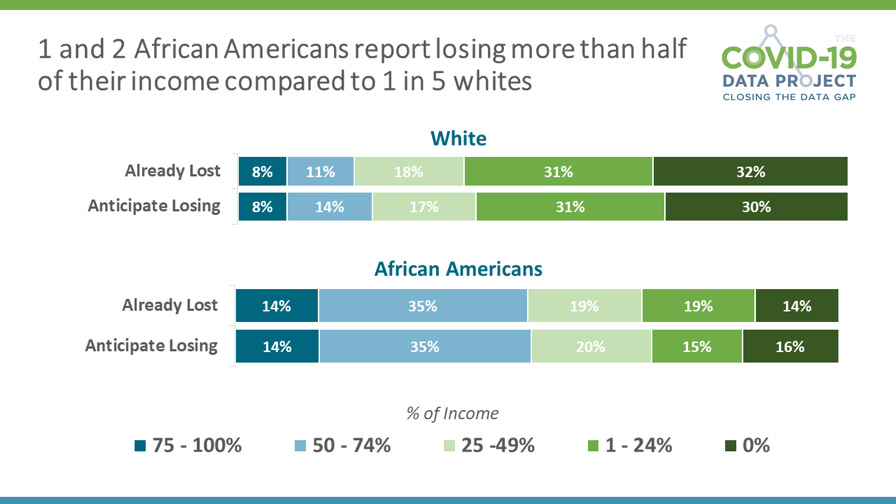
by Stefan Hankin
Since May 25th when police murdered George Floyd in Minneapolis, how this country and white Americans in particular think and talk about race has undergone a seismic shift. Regular visitors to The Covid-19 Data Project know it is focused solely on COVID-19 and not race relations. However, the the pandemic is impacting white and African Americans in very different ways, and that disparity has told a clear story in the data we’re collecting about the pandemic.
We hope this leads to a better understanding and hopefully better discussions and policy outcomes.
Health Disparities
Communities of color have been markedly worse off during the COVID-19 pandemic. From higher infection and mortality rates, the lack of access to care, to the reality that more people of color (especially women) are working on the frontlines as essential workers. From a health perspective, the numbers are downright disturbing. As shown in the chart below, African American and Hispanic residents of New York City have been much more likely to contract the disease, be hospitalized, and to die during the initial phases of the disease spreading in the city.
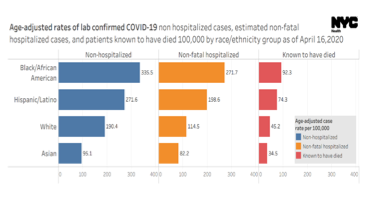
Looking at our own data what jumped out at us is how different the pandemic experience has been for People of Color compared to white Americans. In our COVID-19 Data Project, we have been tracking public sentiment for nearly two months. Over 30,000 Americans have participated so far and the data is pointing to a clear divergence in some very important categories: income loss amid the pandemic, the ability to social distance, and living arrangements. These are all interrelated, but worth looking at one at a time.
Loss of Income
As of late April, a similar number of African Americans and white Americans had reported having lost most of their income due to the COVID-19 Pandemic. However, that has changed over the last two months. As the chart below shows, eight percent of whites and 14 percent of African Americans report having lost 75% or more of their income. The numbers then begin to diverge even more. An additional 35% of African Americans report having lost between half and 74% of their income (24 points higher than whites) and another 38% report having lost some income, but less than half. For white Americans this number is 49%. Among those who have lost no income due to the pandemic we see an 18-point difference between white and African Americans (32% and 14% respectively).
When we asked our panelist about the anticipation of future lost income, we see that both anticipate they will lose more income in the future. However, once again, we see a difference between the two groups. More than 8 in 10 African Americans (84%) anticipate losing some income with 49% anticipating that they will lose at least half of their income. Among white Americans, 70% anticipate losing some income, while 22% believe it will be half or more of what they made before March.
More than 8 in 10 African Americans (84%) anticipate losing some income with 49% anticipating that they will lose at least half of their income
These differences are not just limited to income loss. To help millions of Americans through these economic hardships, Congress passed a series of recovery bills including the most recent CARES ACT that included direct stimulus checks to every American adult earning less than $100K with $500 additional for each dependent. However according to our data from May, white Americans are more likely to have received their check than African Americans.
Despite African Americans having a higher percentage of households with furloughed jobs, pay loss, and unemployment as a result of COVID-19, a higher percentage of white Americans received their stimulus checks than African Americans. More than half of white Americans (53%) report having received a check compared to 47% of African Americans. While this difference is not as large as other disparities it is hugely significant when you look at the people most directly affected by the pandemic.
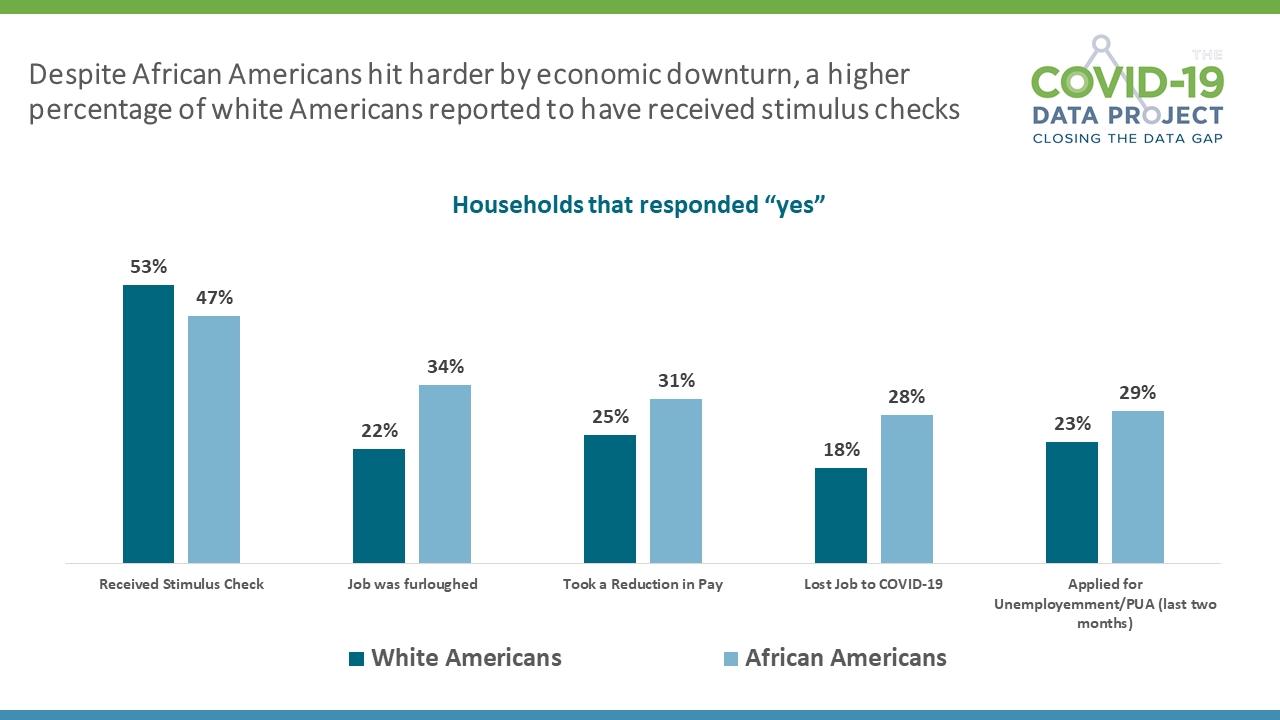
African Americans are more likely to have been furloughed by a 12-point margin. They are more likely to have taken a reduction in pay (6-point margin), and they are more likely to have lost their job (10-point margin). It is also worth noting that while the percent of African Americans who have applied for unemployment is almost identical to those who have lost their job due to COVID (29% compared to 28%), among white Americans more have applied for unemployment insurance than report someone in their household losing their job, 23%-18%.
Given these disparities is it not surprising to see that the spending patterns between how white and African Americans spent their stimulus check is very different. Most notable, white 35% and African Americans spent a very different percentage of their stimulus on food, medical expenses, and debt. Among whites about a third (35%) went to these categories, compared to African Americans who put about half (51%) toward these expenses. Additionally, African Americans spent 29% on their mortgage or rent, compared to whites who spent 13%. The result is that white Americans have yet to spend half of their stimulus check (47%), compared to African Americans that only has on average 15% remaining.
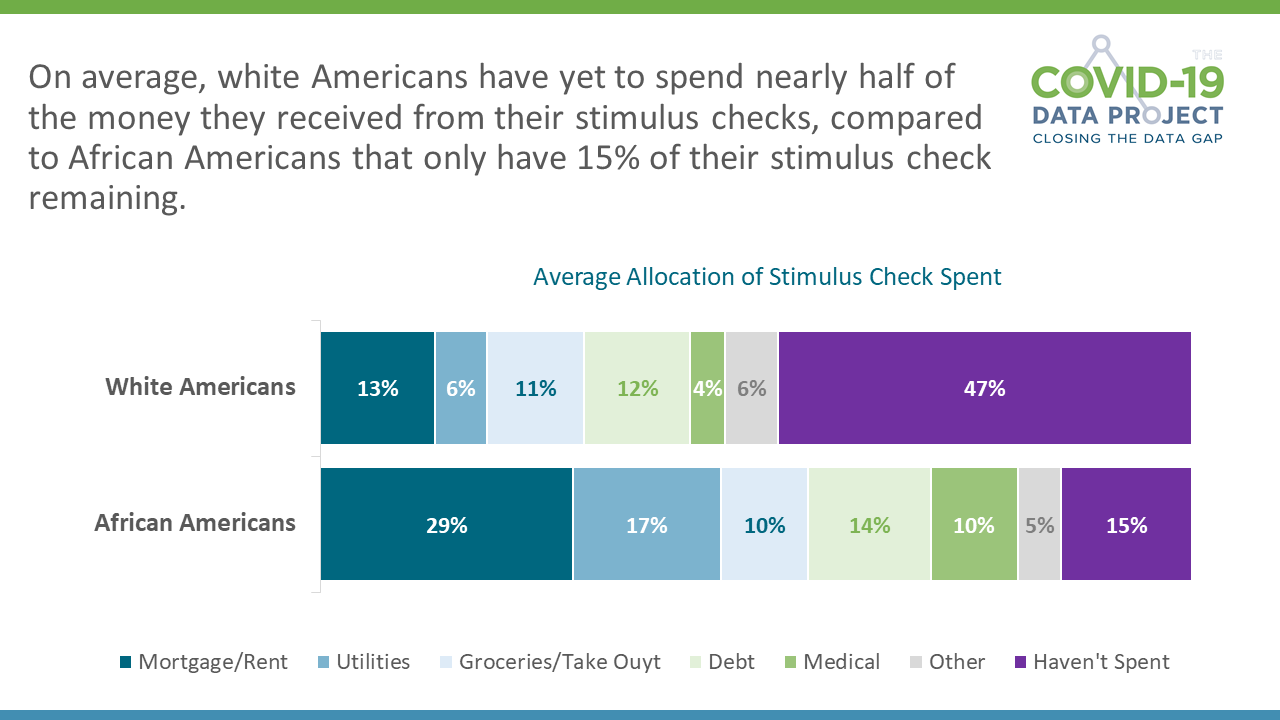
Quarantining, Social Distancing, and Work-From-Home
A significant reason for the disparity in income loss is the difference in the opportunity for African Americans and white Americans to transition their jobs to work from home (WFH) full-time.
Before the COVID-19 pandemic, 16% of white Americans reported working remotely most of the time. An additional 15% said they worked at least half the time out of the office.
During the pandemic, we saw a dramatic shift. Almost half of white Americans reported that they began working at least four days a week from home, a nearly 300% increase. Further, 60% of whites say they can work 50% or more of the time from home.
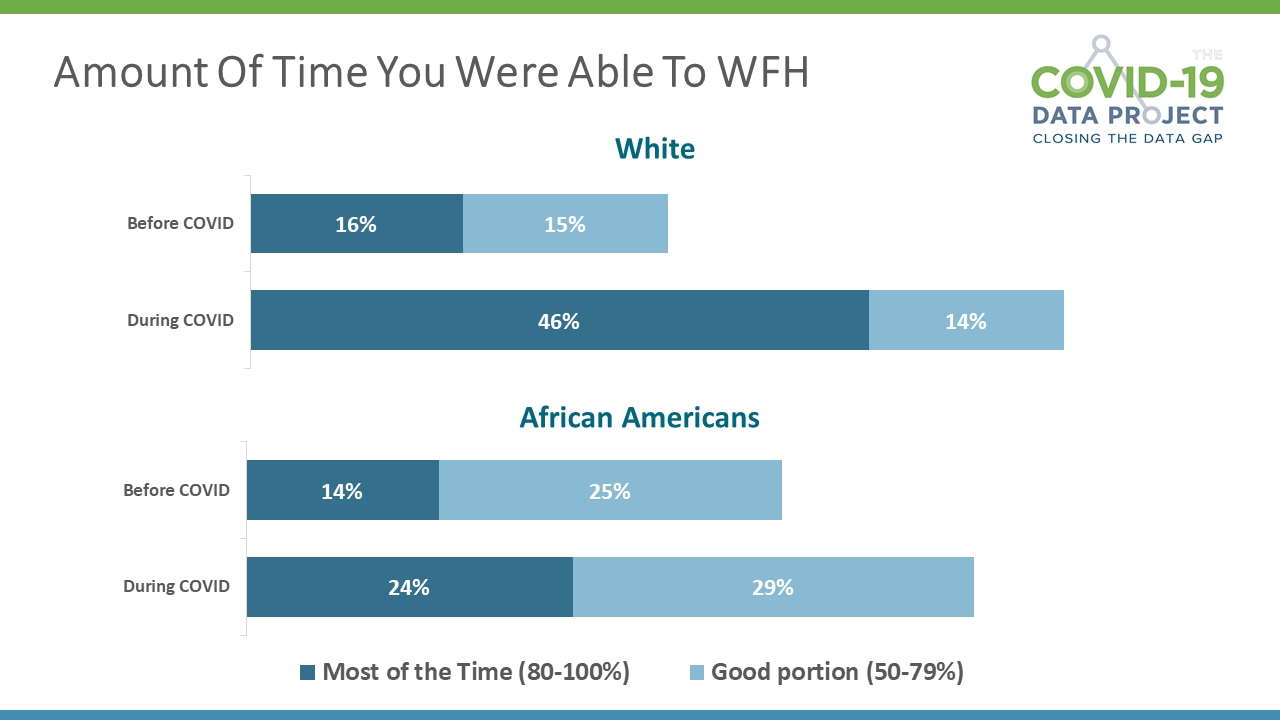
When we look at these numbers among African Americans, we see a completely different picture. Before COVID-19 the percent of African Americans who worked 4 or 5 days from home were similar to white Americans (14% and 16% respectively). There was an even higher percentage of African Americans reporting that they could work 2-3 days from home (25%) compared to whites (15%).
After COVID, the percent of African Americans who began to work from home only increased by 10 points, a third of the increase afforded to whites. If we look at those spending most of their time working at home, 53% of African Americans fall into this category compared to 60% of whites. Given what we know about the spread of the virus, the inability to work from home is a factor in the adverse effects when it comes to the number of cases and deaths.
These numbers also affect the ability to social distance. African Americans are 7% less likely than white Americans to practice social disatancing and are more likely to have gone to a public venue (21% compared to 11% of whites) and to have had physical contact with someone outside of their household (37% vs 30%). The inability to work from home clearly affects these numbers.
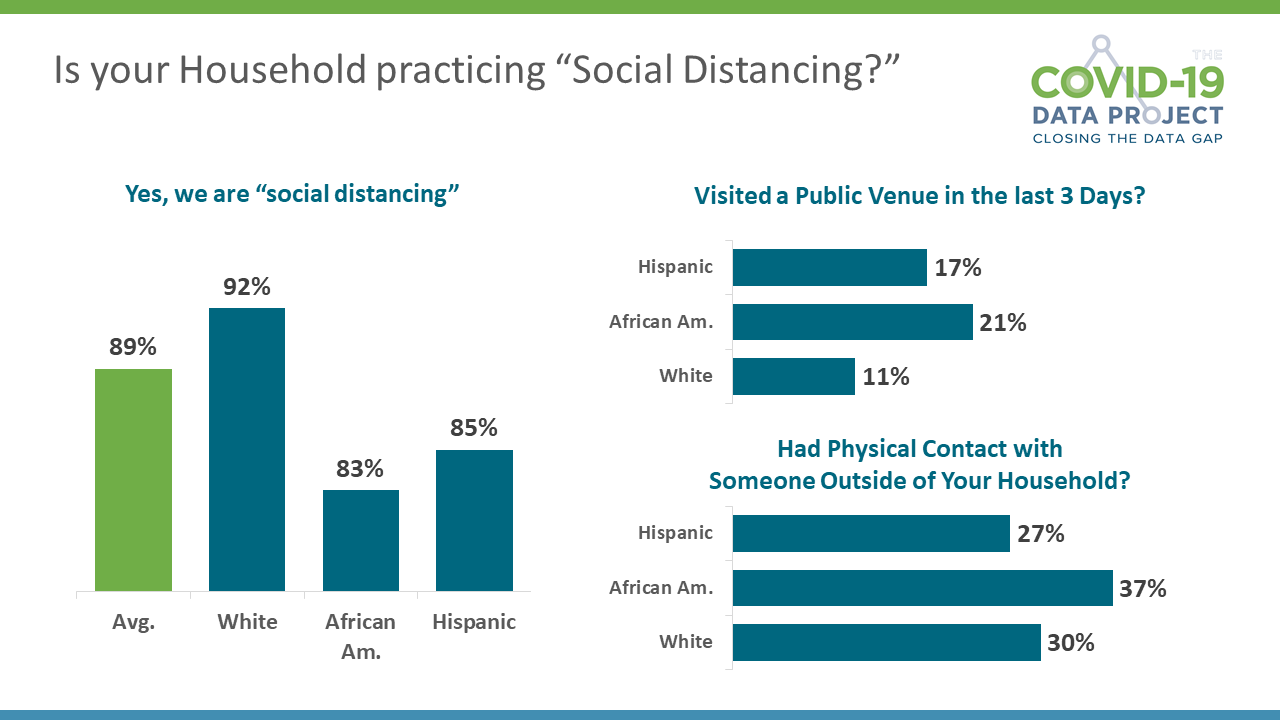
Another factor is where people are living. Currently, 85% of white Americans report that they are living in their primary residence and 4% are living with a family member or at a friend’s residence.
African Americans are living very differently. Just 56% of African Americans report that they are quarantining in their primary residence, and the number of African Americans quarantining at a friend’s or family member’s house is three times higher than among whites (13% compared to 4%). When it comes to quarantining in a primary residence, the 30-point drop tells a story of two different Americas.
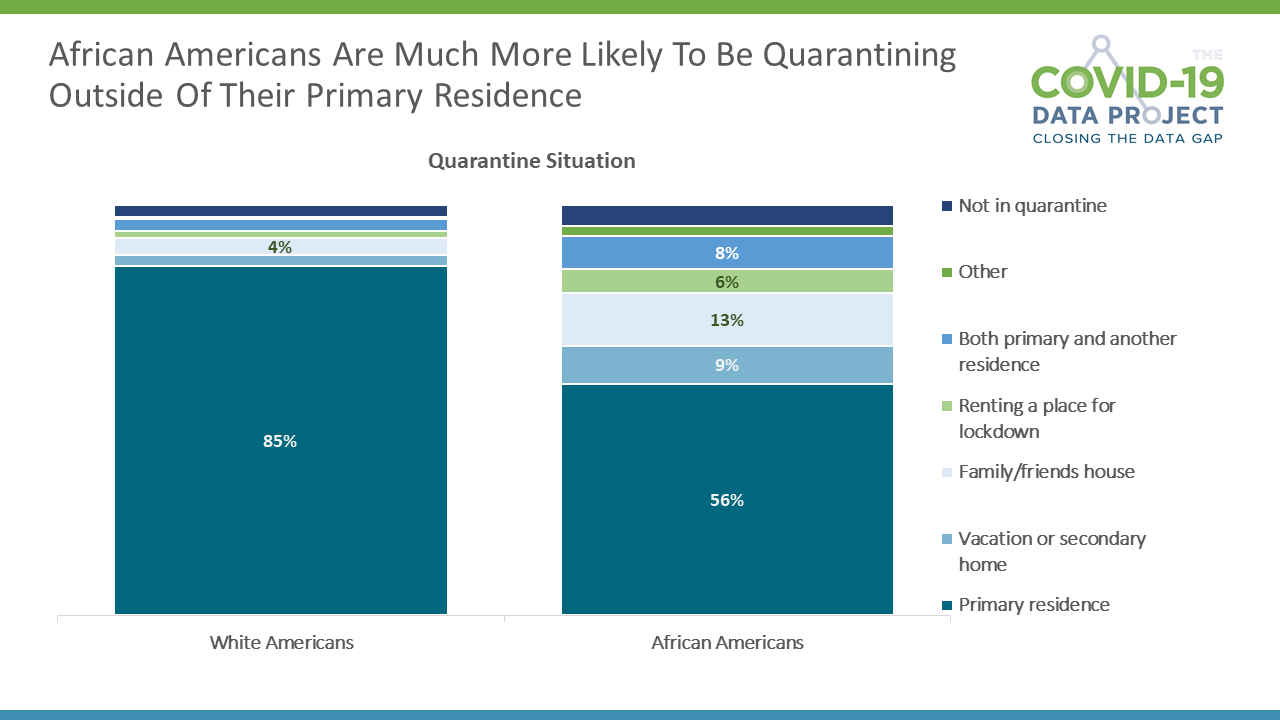
We are also quarantining with different people. The vast majority of whites (63%) report that they are quarantining with a married partner or spouse; less than a quarter for African Americans (23%) are as well. African Americans are slightly more likely to be quarantined with an unmarried partner than whites (8% and 6% respectively). With this being said, African Americans are three times more likely to be quarantined with other family members, though both cohorts are as likely to have adult children in their house (15% vs 13%).
Another point worth noting is that African Americans who are quarantining with a significant other are more likely to think their relationship has suffered because of the quarantining situation and much less likely to feel like things have gotten better. Indeed, 24% of whites quarantining with a significant other say that their relationship has gotten much better, while just 8% of African Americans feel the same way.
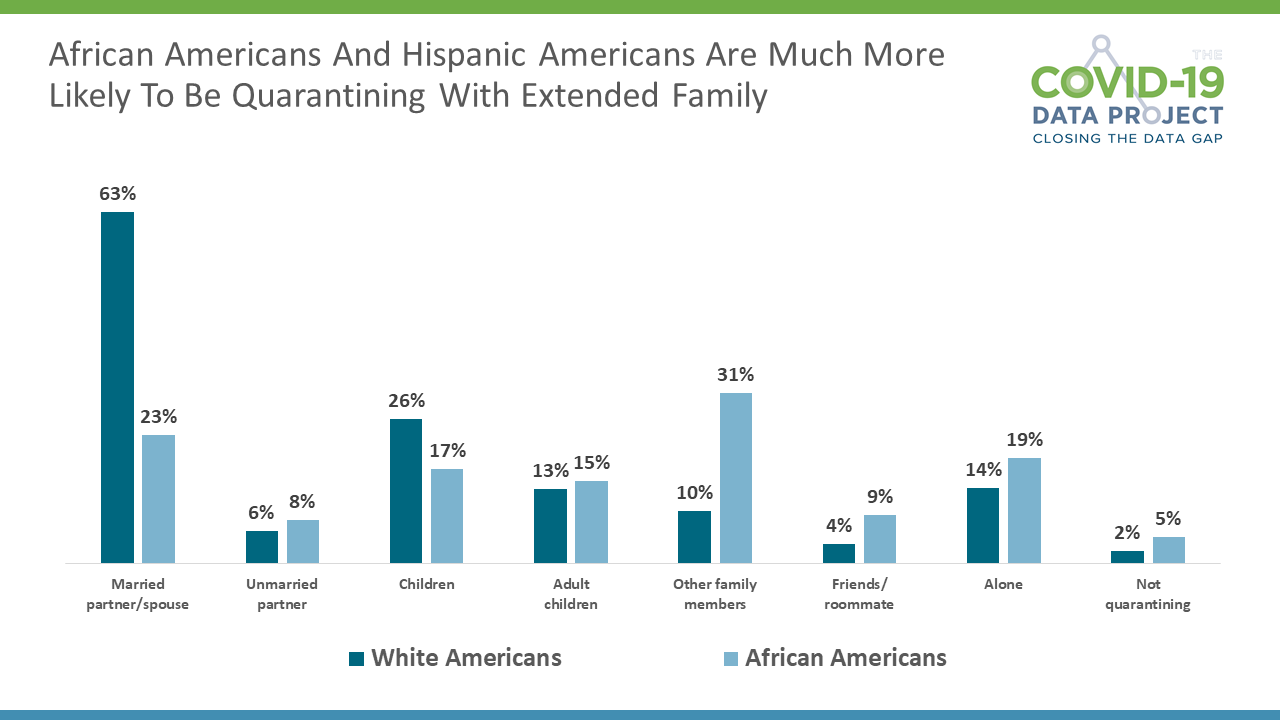
To generalize the experience of the “average” white American in the COVID-19 pandemic, we observe little to no loss of income, an ability to transition to work from home, sharing space with a married partner, and an overall enhanced ability to maintain social distancing. The “average” African American has lost at least 25% of their income, has not been given the opportunity to (or has the ability to) work from home, is more likely to be living somewhere other than home, is less likely to be with a married partner, and is more likely to be living with extended family.
The reality of income inequality across race not only lies within a difference in yearly income but in the disparity in the reliability, transitivity, and the benefits garnered from higher-paying jobs. All of these factors impact access to healthcare, job retention amid lockdowns, and overall financial stability, which in turn, impact health. In addition, the higher percent of African not able to live at a primary residence and higher number of people in a household not able to work from home increases the chances of exposure. Based on this data, it should not be a shock that we are seeing these results play out across the country. All of these factors have given African Americans a higher chance of contracting COVID-19.
What do you think of today's email? I'd love to hear your thoughts, questions and feedback. I might even put ‘em in the newsletter if I don’t steal it outright.
Enjoying this newsletter? Forward to a friend! They can sign up here. Unless of course you were forwarded this email, in which case you should…
Want a way to send gifts and support local restaurants? Goldbelly’s got you hooked up. I just sent a friend kolaches, which, if you don’t know what they are, YOU NEED TO ORDER YOURSELF SOME NOW.
I used this to order scotch delivered right to my door. Recommend.
I’ve lost 30 pounds since the beginning of this year with Noom, and haven’t had to cut out any foods. Noom is an app that uses psychology, calorie counting, and measuring activity to change your behavior and the way you think about food. I’m stronger and healthier than I’ve been in years. Click on the blue box to get 20% off.
If this newsletter is of some value to you, consider donating. Honestly, I’m not doing this for the money. I’m writing this newsletter for myself, and for you. And a lot of you are contributing with letters and by suggesting articles for me to post. But some of you have asked for a way to donate money, so I’m posting my Venmo and PayPal information here. I promise to waste every cent you give me on having fun, because writing this newsletter for you is some of the most fun I’ve had. Venmo me at @Jason-Stanford-1, or use this PayPal link.



